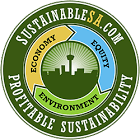The Four E’s of Social Media & Sustainability:
 The TakeAway: Sustainability Leaders Need to Use Social Media to Exchange, Educate, Engage, and Enhance.
The TakeAway: Sustainability Leaders Need to Use Social Media to Exchange, Educate, Engage, and Enhance.
Social media has exploded within the past few years to become a fixture in our culture. For example, Facebook’s network has mushroomed to 500 million users and Twitter attracts 190 million visitors a month, who generate 65 million Tweets (or 140-character updates) a day. And the UN estimates cell phone users will number 5 billion globally this year, with one billion people using smartphones to access Web applications such as Facebook and Twitter.
Yet most firms and NGOs have only dipped their toes into social media. This, despite the potential social media offers to access information, build knowledge, connect with stakeholders, and improve performance. A recent McKinsey report on “Ten Tech-Enabled Business Trends to Watch” cites the need for organizations to “think strategically about how to adapt management and organizational structures to meet these new demands.”
We’ve identified four categories for using social media to achieve sustainability: Exchange, Educate, Engage, and Enhance.
Exchange | Social media allows you to point your megaphone wherever you want, in a “one-to-many” broadcast. But listening – a forgotten art in a world of data dumping – also plays a key role in creating two-way exchange. Social media enable you not only to monitor breaking news, but also discuss it, therefore helping to form influential opinions. These exchanges can help correct or clarify misconceptions, as well as call people to action. Twitter hashtags (#) allow you to track – and add to – exchanges by topic; some of our favorites include #sustainability; #csr for corporate social responsibility; #ESG for environmental, social, and governance matters; #corpgov for corporate governance; and #finreg for financial regulation reform. Educate | Social media carries huge potential to educate, where users can both teach and learn. The proliferation of webinars exemplifies this, as does the rise of “user-generated” content, such as Wikis, question-answer databases, and discussion boards. These tools encourage two-way conversations that “stimulate continuing participation and commitment,” as the McKinsey authors write. And Creative Commons makes it easier to “increase the amount of creativity (cultural, educational, and scientific content) in ‘the commons’” without losing copyright permission. Engage | Few firms currently use social media to engage stakeholders, but that is quickly changing. Bill Baue and I cite examples where firms and stakeholders increasingly engage online in The Accountability Web: Weaving Corporate Accountability and Interactive Technology, a research project of the Corporate Social Responsibility Initiative at the Harvard Kennedy School. We identify the following progression in engagement (followed by case examples):
- One-way Proclamations: McDonald’s Values in Practice blog;
- Reactions: Nestlé Waters’ Things to Know videos;
- Interaction: Shareowners.org platform for investor activism;
- Deeper Dialogue: SAP’s interactive Sustainability Report;
- Genuine Collaboration: Timberland’s Voices of Challenge stakeholder engagement portal.
Enhance | Going forward, social media can help enhance performance, particularly on sustainability. For example, the 2degrees network of 8,000 sustainability professionals participate online in facilitated problem-solving through virtual seminars, open innovation challenges, and “best practice” exchanges. This represents a “community of inquiry and practice”, where members improve professional performance, develop new skills, and even create new knowledge to replace outdated assumptions.
Given the rapid pace of technology innovation, sustainability leaders can’t afford to watch from the sidelines. When it comes to advancing sustainable prosperity, we all act as learners and innovators. We can practice the 4 Es of social media to help make the transition to a more just and sustainable world.
Originally published at the The Murninghan Post – read more…
